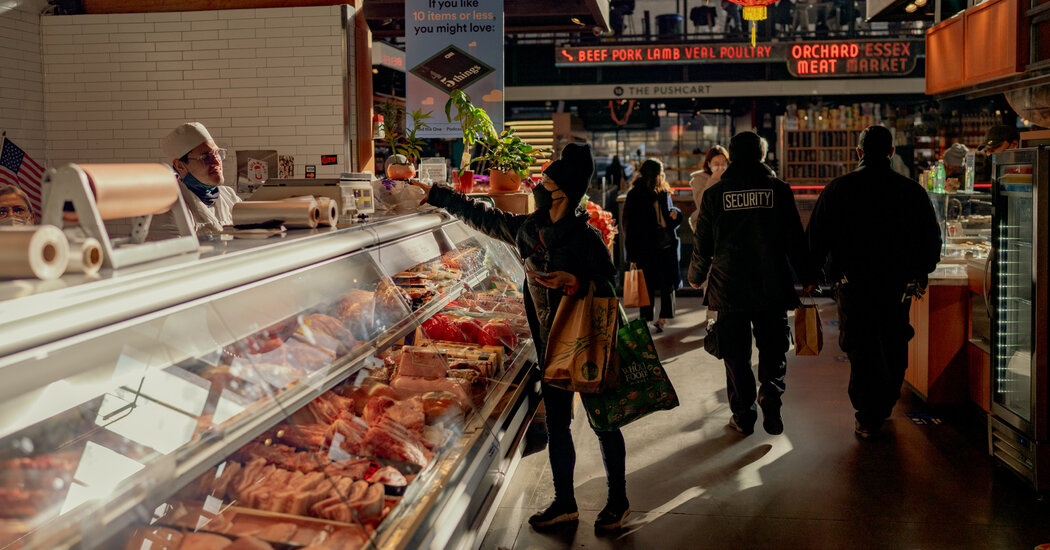
A key inflation measure showed that prices are climbing at the fastest pace in 40 years and more quickly than economists had expected, the latest unpleasant surprise for the White House and Federal Reserve after a bruising year for American consumers.
Consumer Price Index data for January, released Thursday, showed that prices have climbed 7.5 percent over the past year, more than the 7.2 percent projected in a Bloomberg survey. On a monthly basis, they picked up 0.6 percent.
That is rapid by historical standards, and although it is slower than the fastest monthly increases in 2021, it too was above economists’ expectations.
After stripping out food and fuel — the prices of which move around a lot from month to month — inflation climbed 6 percent, the fastest pace since 1982.
Forecasters anticipate that inflation will come down meaningfully in 2022: Many expect it to finish the year closer to 3 percent. But economists regularly predicted that price gains would fade quickly in 2021, only to have those projections foiled as booming consumer demand for goods collided with roiled global supply chains that could not ramp up production fast enough.
In the meantime, price increases are hitting consumers in the pocket book. January’s inflation was driven by food, electricity and shelter costs, the Bureau of Labor Statistics said.
Policymakers have expressed more humility around their outlook for inflation in recent months, especially at a time when ports remain clogged, rents and restaurant prices are on the upswing and wages are rising, all factors that could keep inflation hot.
High inflation has been a political liability for the White House, because rising prices have eaten away at household paychecks and detracted from a strong labor market with solid wage growth, leaving consumers feeling pessimistic. It has also prompted the Fed to pivot away from its patient policy setting meant to foster a quick economic rebound from the pandemic, including keeping interest rates at rock bottom. Investors now expect that central bankers might lift interest rates six times this year as they try to slow down the economy and tamp down price gains.
“Making appropriate monetary policy in this environment requires humility, recognizing that the economy evolves in unexpected ways,” Jerome H. Powell, the Fed chair, said at his news conference last month.
The Fed aims for 2 percent inflation on average over time, though it defines that target using a different inflation index that is also elevated but not quite as sharply. The new data “underlines our view that a rapid cyclical acceleration in inflation is underway and, with labor market conditions exceptionally tight, it is unlikely to abate any time soon,” Andrew Hunter, senior U.S. economist at Capital Economics, said in a note following the release.
While Mr. Hunter said inflation should fade this year, the data suggest it “will remain well above the Fed’s target for some time.”
The factors behind inflation appear to be broadening. Price increases in 2021 were driven heavily by roiled supply chains that sent new and used car prices and furniture costs up drastically. While those continue to be a big factor elevating overall inflation other areas are also fueling the rapid rise.
Rent of primary residence, which counts for a big chunk of overall inflation and tends to respond more to economic conditions more than to unusual one-off trends, climbed by 0.5 percent in January from the prior month, a slight acceleration. Other shelter costs continued to climb at a steady but notable pace.
As shelter and other services costs pick up, policymakers are hoping that supply chains will start to catch up this year. That could allow goods prices to moderate or even fall — taking pressure off overall inflation.
It is not clear, however, how quickly that is going to happen. Protests in Canada that have clogged a key trucking route and disrupted parts delivery to car manufacturing plants. Even if those are not especially disruptive, some industry experts are not predicting a big drop in automobile prices this year.
“The growth rate of vehicle prices — these crazy numbers we saw in 2021 — should start to slow,” said Charlie Chesbrough, senior economist at Cox Automotive. But demand remains robust, and “we’re so far behind on the manufacturing side.”
While the White House has rolled out policies that might help with high inflation around the margins — releasing strategic petroleum reserves and discussing ways to place military veterans into the short-staffed trucking industry — the Fed is primarily in charge of slowing down demand to keep prices under control. Congress has assigned the central bank two main jobs, fostering full employment and price stability.
Fed officials have signaled that they will begin raising interest rates in March. Higher rates can slow down consumer and business spending by making it more expensive to finance a car, house or machine purchase. Policymakers have also suggested that they will soon begin to shrink their balance sheet of bond holdings, which should push longer-term interest borrowing costs and further cool off the economy.
The Fed’s policy response, together with a slow return to more normal business conditions, is expected to slow price gains in the months ahead.
Consumers have also been buying goods at an unusually rapid clip, but recent data have suggested that they may be in the process of shifting back toward spending more heavily on services.
Still, rising pay may increase the risk that inflation remains too high for comfort this year. Jobs data released last week showed that average hourly earnings climbed rapidly — and much more than economists expected. Companies may be able to offset rising labor bills with productivity improvements, but if not, they might pass those costs along to customers to protect their own profit margins.
Plus, if consumers are earning more, they may be able to spend more on big necessities — notably rent. If housing prices continue to rise, that could help to keep inflation elevated, since rents make up a big chunk of the overall measure.
That said, corporate profits presently look very strong and productivity is high, which may give companies room to absorb bigger wage bills. And in recent decades, the relationship between wage growth and inflation has been weak.
Some economists even worry that the Fed might act too aggressively, slowing down the economy just as price gains moderate on their own.
“My concern is that they overdo it — being too sensitive to wage growth,” said Ryan Sweet, who leads real-time economics at Moody’s Analytics. “This is not going to be easy.”
The economy has been challenging to predict in the aftermath of state and local lockdowns meant to control the pandemic, and as the virus continues to disrupt ordinary economic patterns. On one hand, job openings are plentiful and workers seem to have newfound power in negotiating better pay and conditions. On the other, the rapidity of price increases has come as a constant surprise.
Much like policymakers, companies have expressed uncertainty about when today’s rapid price gains will fade.
“I wish I could forecast when this inflation is going to slow down,” Brian Niccol, Chipotle Mexican Grill’s chief executive, told Bloomberg News in an interview this week. “But unfortunately, we’re not getting a sign that it’s going to slow down.”




